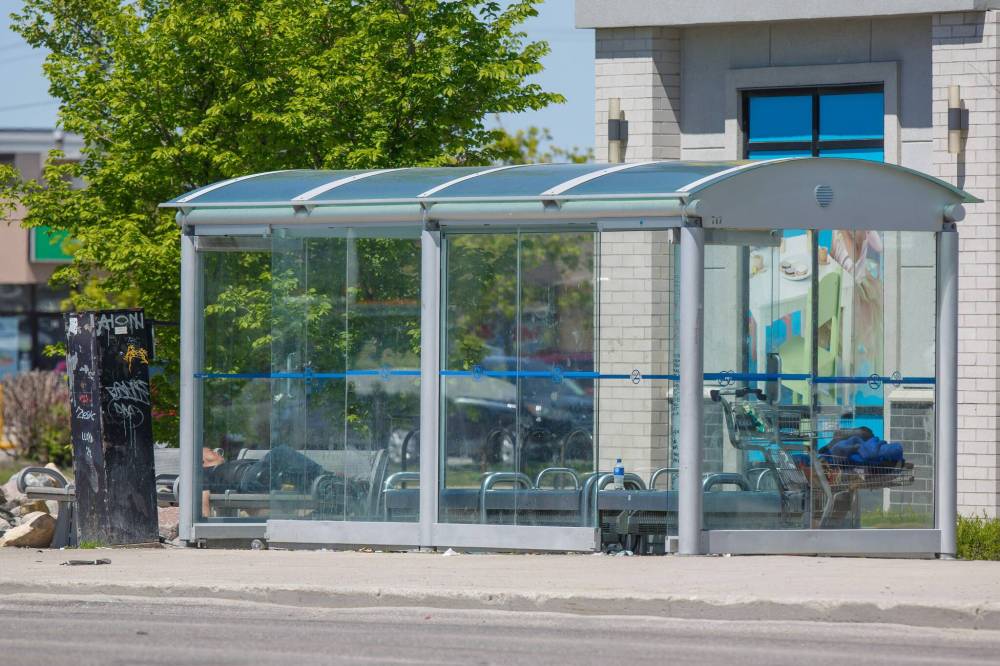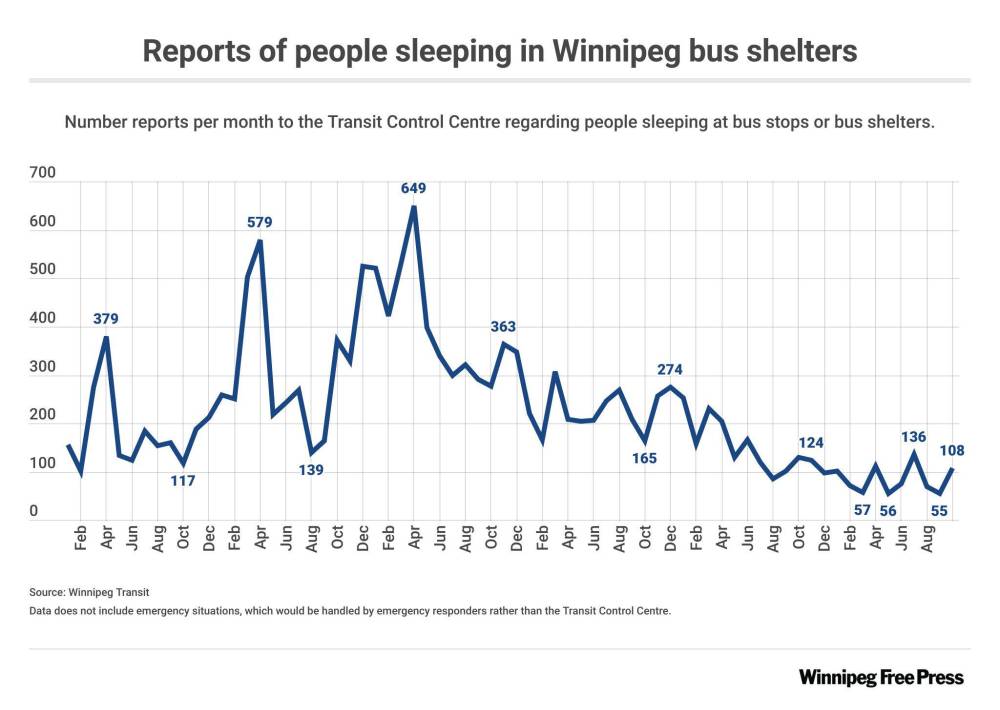During nine of the last 10 months, Winnipeg Transit recorded the lowest number of people sleeping in bus shelters since at least the beginning of 2019.
The Transit Control Centre received 102 reports of people sleeping in bus shelters or at bus stops in January, compared to an average of 282 for that month between 2019 and 2023. There were 72 reports in February, compared to an average of 220, while fewer than 100 reports were filed in each of February, March, May, June, August and September.
July was the only month with a slight increase over the same period in the previous years noted, with 136 reports this year, up from 120 in 2023.

MIKE DEAL / FREE PRESS FILES
Winnipeg Transit said employees who observe someone sleeping in a shelter are expected to report the matter to the control centre.
Each month’s count was significantly less than those from 2021, when the problem spiked to its highest level.
Mayor Scott Gillingham said the data offers an early sign that key city investments are working.
“I made a campaign commitment to make investments to get people out of (living in) bus shelters and I believe that our intentional investments as a council are beginning to show impact,” he said.
“We’ve invested in 24-7 safe spaces to provide people an alternate space to get out of bus shelters and into a warm space. We invested in community safety officers and (the) downtown community safety partnership. Both of those organizations connect people in bus shelters to the services that they need.”
However, he cautioned that more time is needed to determine whether the city has turned the corner. The goal is to get the number to zero because of better accommodations.
“The problem and challenge has not gone away. There’s still work to do,” said Gillingham.
The mayor noted the city still faces widespread homelessness, emphasizing efforts to attract more housing and secure more federal funding to address encampments must continue.
Winnipeg Transit said employees who observe someone sleeping in a shelter are expected to report the matter to the control centre. Members of the public who call 311 about an emergency involving someone sleeping in a bus shelter will be directed to call 911 and those calls may not be reported to the Transit control centre, a spokesman noted.
The leader of an organization that provides outreach services to homeless Winnipeggers said she has noticed a decline in people staying in bus shelters but the number of people living in homeless encampments is on the rise.
“Encampments have become places for people that normally would have been in a transit shelter (before)…. We’re seeing encampments that are much (more heavily) populated than in the past,” said Marion Willis, executive director of St. Boniface Street Links.
“An encampment can be a whole series of tents now, like a community…. It’s not that there’s less people living homeless, that’s for sure. It’s (a change in) how unsheltered people are choosing to live.”
Willis said Street Links cleaned up significant encampments on Midwinter Avenue and Fermor Avenue this week, after finding better places for the people living in them to stay.
“(Encampments) are, honestly, everywhere. There’s so much more activity… than people realize,” said Willis.

Jason Whitford, chief executive officer of End Homelessness Winnipeg, said there has been high demand for spaces in city homeless shelters.
“It’s a reflection of the growth of the unsheltered population. And it’s often more visible when colder weather arrives and people will seek refuge in the only available space, (which can include) bus shacks,” said Whitford. “Ultimately, the solution is longer-term, sustainable and safe housing.”
The union representing crews that clean transit shelters said there are public health and safety risks that arise from people living in them.
Chris Scott, president of the Amalgamated Transit Union Local 1505, which represents crews that clean transit shelters, noted the health and safety risks that arise from people living in them. He said it appears the problem is less widespread now.
He suggested mild fall weather may be having an effect, leading more vulnerable people to remain outdoors instead of seeking warmth in heated bus shelters.
Once colder weather sets in, Scott said missing panes of glass in many vandalized shelters will reduce numbers, as well.
“Without the shelter from the elements, whether it be driving rain… or snow, with no walls and no heat… that could (impact this),” he said.
joyanne.pursaga@freepress.mb.ca
X: @joyanne_pursaga

Joyanne Pursaga
Reporter
Joyanne is city hall reporter for the Winnipeg Free Press. A reporter since 2004, she began covering politics exclusively in 2012, writing on city hall and the Manitoba Legislature for the Winnipeg Sun before joining the Free Press in early 2020. Read more about Joyanne.
Every piece of reporting Joyanne produces is reviewed by an editing team before it is posted online or published in print — part of the Free Press‘s tradition, since 1872, of producing reliable independent journalism. Read more about Free Press’s history and mandate, and learn how our newsroom operates.
Our newsroom depends on a growing audience of readers to power our journalism. If you are not a paid reader, please consider becoming a subscriber.
Our newsroom depends on its audience of readers to power our journalism. Thank you for your support.